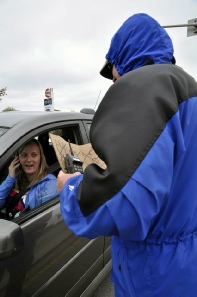

No escaping hobo cop: New tactic aims to catch drivers using cell phones on the road
BURLINGTON, Ont. —A scruffy looking man —hoodie up, clutching a tattered sign scrawled on a scrap of cardboard —shuffled up to a car at a busy intersection in this city west of Toronto. Drivers instinctively looked away.
But this sign’s wording was different from the usual begging appeal: “My name is Constable Mike Cairns. If you are reading this sign you are about to get a cell phone ticket.”
Witness the latest police tactic in the crackdown on distracted drivers.
Across Canada over the past several weeks, police officers have been dressing as panhandlers and clutching cardboard signs to mimic the curbside come-
In a growing list of cities, the unusual undercover tactic is snagging motorists who are texting, dialling, emailing or holding cell phones.
In Ottawa, an officer with an eye for authenticity scrawled “God bless” at the end of his cardboard sign.
In Salmon Arm, B.C., an RCMP corporal had spelling errors and a smiley face drawn on his sign as he plodded up and down a meridian in the Trans-
And in an apparent Canadian first in the genre, RCMP Constable Bryan Martell in Chilliwack, B.C., has been wearing a hoodie pulled up over a baseball cap with a pair of baggy, combat fatigue pants while clutching his greasy, cardboard sign written in all capital letters.
The tactic is dubbed Hobo Cops.
But not everyone is happy with it.
Anti-
“We don’t want to give panhandlers a bad name by people thinking that they’re cops,” said John Clarke, an organizer with the Ontario Coalition Against Poverty.
“They are displacing people who are trying to survive by panhandling. The level of social cutbacks is such that, for panhandlers, there are no survival margins at all. And from a general decency point of view, it is a sneaky and unsavoury tactic.”
“We don’t want to give panhandlers a bad name by people thinking that they’re cops”
Despite the complaints, the new tactic’s success is apparent.
In Burlington, over two days this week, two youthful-
The idea is for police to have a way to walk up to the vehicles and look inside to see what motorists are doing without drivers adjusting their behavior the way they would if a uniformed officer stood there.
“It’s the texters that are the most dangerous and they’re the most difficult to catch,” said Sergeant Chantal Corner of Halton Regional Police who helped run Burlington’s hobo sting.
“Cell phone users, you can see them holding their phone up to their ear, but those texting —you see them driving around with their head down but you can’t see the device. It’s hard to prove they were texting. By the time we pull them over they have put it away and deny it.”

Officers wore their police badges on a chain around their neck and identified themselves when interacting with a distracted driver, ordering them to pull over where uniformed colleagues were waiting. Two drivers tried to flee but were apprehended, said Sgt. Corner.
The officers handed out 61 provincial offence notices for distracted driving offences on Monday and another 111 on Tuesday. The numbers from Wednesday’s enforcement blitz were not yet available.
“We understand people will be upset. Nobody likes to get a ticket. But the other 90% of the people, they thought it was great. People were saying it’s about time,” said Sgt. Corner.
One driver defended herself by saying she grabbed the phone to avoid a confrontation with a suspected beggar. Sgt. Corner checked with the undercover officer, who said the driver pulled up at the intersection already on the phone.
It is the kind of discrepancy that needs to be settled in court and is part of the shaking out process every new police tactic typically needs.
“Distracted driving is so rampant,” said Sgt. Corner. “We need to send the message: put the phone in your purse or in the trunk or in the back seat, anything to help you avoid the temptation of that buzzing.”
The hobo cop is a variation on undercover techniques police use to avoid suspicion as they watch for crimes and infractions.
Over Easter, an RCMP sergeant in Nanaimo, B.C., wore a seven-
Retired RCMP constable Tim Shewe, who spent 20 years working in traffic enforcement and another 10 years in collision investigation, defended the techniques.
“How would you deal with distracted driving when you are in a marked cruiser you can see a mile away? They see you, put the phone down and sit back straight until the officer is out of sight and then go right back to it. People have to learn and if that means officers not being visible then that’s the way to do it,” he said.
| Site Map |
| Awards Meeting Feb 23 2017 |
| About Us |
| Why a Crime Commission |
| Privacy Statement |
| Search Results |
| Membership Link |
| Short Contact Form |
| Events Link |
| Lation Police Officers Boxing |
| Media Link |
| Videos |
| News |
| Archive |
| Chief Aceves Resignation |
| Tips On Crime |
| Crime Technology |
| The Future is Here |
| Garage protecting video |
| On Line Privacy |
| Contact Page |
| LInks |